Table of Contents
1. How do trash management challenges impact residents?
2. Whose Responsibility is it? Trash, Accountability, and Power
3. Imagining Solutions: What Can and Should Be Done?
How do trash management challenges impact residents?
Emotional Impact: Pain, shame, despair, hope
Participants shared general feelings of discontent and frustration with the trash management in Greater Hartford. Upon reflection, several participants discussed how poor trash management has affected their sense of community and connection to their neighborhoods. The seemingly intentional neglect of waste management services in marginalized neighborhoods was associated with painful memories and shame for participants.
Speaking of the contrast between Hartford and its surrounding suburbs and how it shaped her own feelings about her neighborhood growing up, Tatiana Hilario, a New Britain resident, explained:
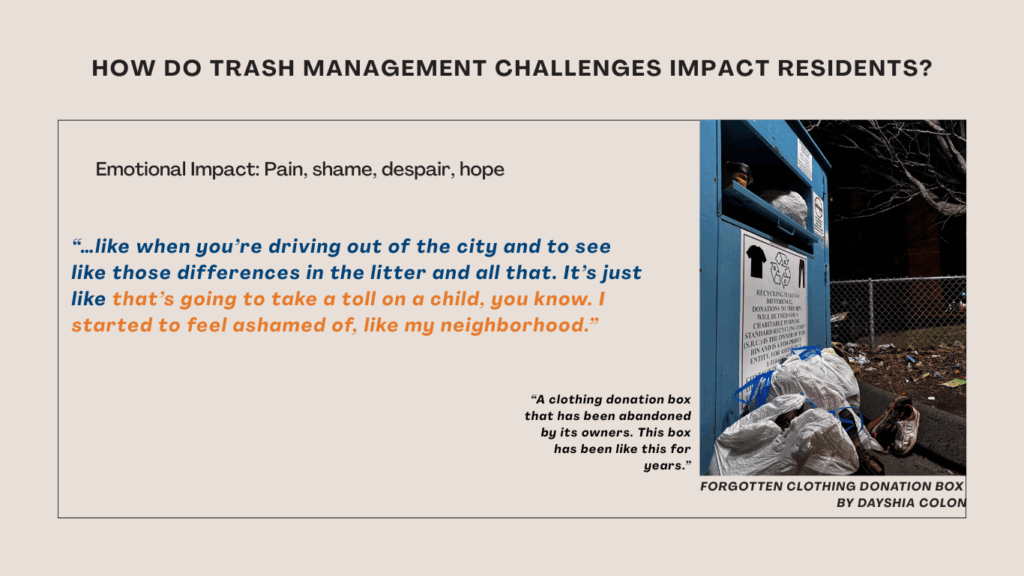
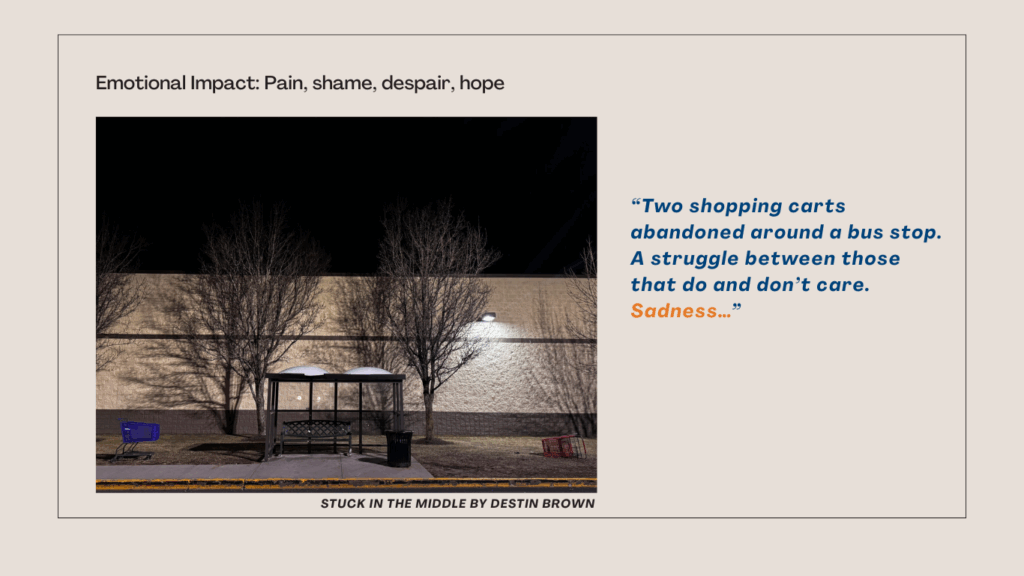
Intersection of Inequalities – Transportation and Mobility Challenges
Participants’ photos revealed how challenges with waste management intersect with inequalities in other public services. In particular, three of the seven participants included a photo of trash on public transportation vehicles or at bus stops. They reflected on how the condition of bus stops and transit infrastructure contributed to a greater sense of neglect in their communities. They emphasized the difference between well-maintained transit areas in downtown corporate areas and the deteriorating conditions in surrounding neighborhoods. Participants highlighted how this uneven distribution of resources felt intentional, reinforcing a sense of exclusion and devaluation. The daily experience of navigating unreliable and poorly maintained transit systems served as a constant reminder of systemic inequality, shaping how residents perceived their place within the city.
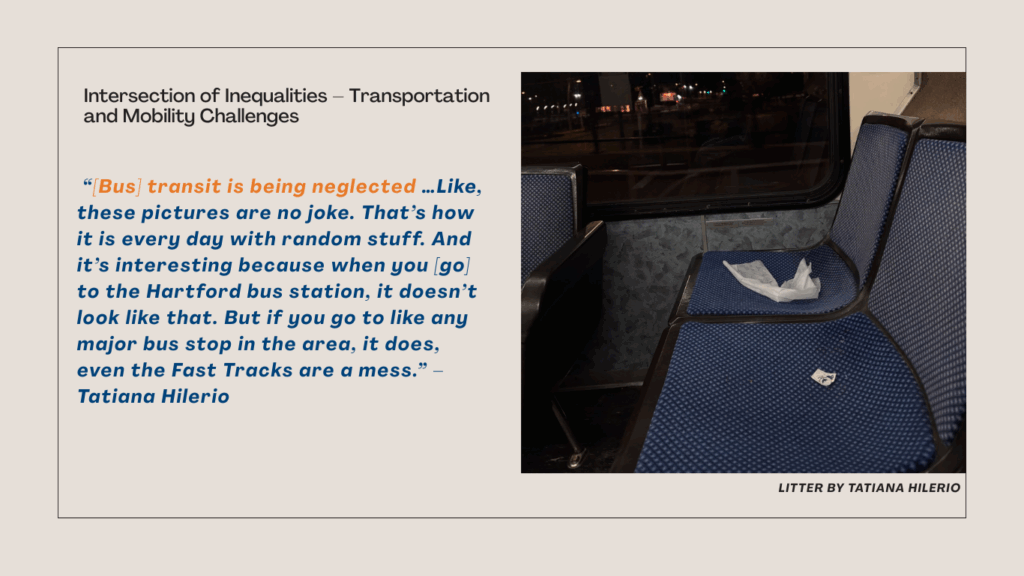
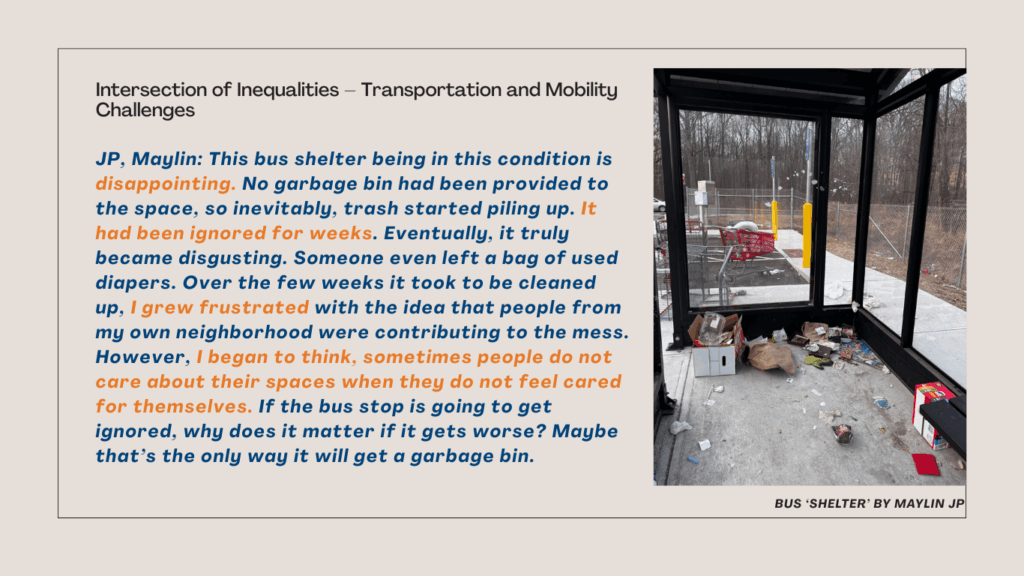
Whose Responsibility is it? Trash, Accountability, and Power.
Another key theme discussed among PhotoVoice participants was differing ideas on who is responsible for managing trash and who was to blame when it is mismanaged. Participants wondered if individuals were primarily responsible for managing their own trash, and were at fault when litter built up. But they also questioned if the city of Hartford or surrounding suburbs were providing enough systems to support individual trash management efforts. Some participants felt that Hartford residents were blamed for dirty neighborhoods, when in fact suburban residents contribute to mismanaged trash in Hartford.
“who bears the brunt of it? It is like important to know when like, okay, is this my turn to be responsible or is this my turn to hold somebody to be accountable for something? It really isn’t your job, it is your property, but it’s not necessarily your job… like you said, you have to have the knowledge. We really don’t have the knowledge, but it is on the people who have access to knowledge, (it is their) responsibility to take care of things like that.” – Maylinn Juarez
Hartford residents expressed feeling neglected by the government in terms of trash management and raised the question who should be held responsible? Multiple participants acknowledged the street sweepers that only clean certain areas.
“You go on Pratt Street at any time of the day and you’re going to see someone sweeping Pratt Street. But those are for the tourists that have the money, that can leave and go home to their clean, safe neighborhoods. You know? But then it’s like, they come in here and all I hear is ’Hartford is so dirty, Hartford is so dangerous.’ But it’s like, how can you say that about my city?” – Maylin Juarez, New Britain
Participants noted that when your community is treated like a dump, you begin to think of it as such, losing motivation for keeping it clean.
“It’s a lack of pride in their community because, for example, if you have a car and you love your car and you take pride in your car, you’re going to make sure it’s clean. So, if you love where you live, you’re not going to want to see it that way. And I feel like a lot of people just either don’t have the knowledge or the money or the pride in their community to care enough to not just throw trash everywhere.” – Destin Brown
Unequal Resources and the Urban-Suburban Divide
Despite the responsibility aspect of waste management, there is also frustration with the inequality of resources for low-income communities. Specific areas of Hartford are neglected because of the lack of government funding for spaces that do not attract tourism or have financially impactful businesses. Because certain areas of Hartford receive more resources and better waste management, an unfair trash burden is placed on low-income communities of color. This burden has left Hartford residents with a feeling of helplessness and anger towards those who disrespect the city in which they grew up.
Destin Brown mentions education as well. Properly educating residents on regional waste management practices and ensuring that neighborhoods are given an adequate amount of waste bins can reduce pollution. Suburban participants mentioned having access to composting and recycling services which are not offered to city residents. This inequality of opportunity and resources further exacerbates waste management issues in Hartford.
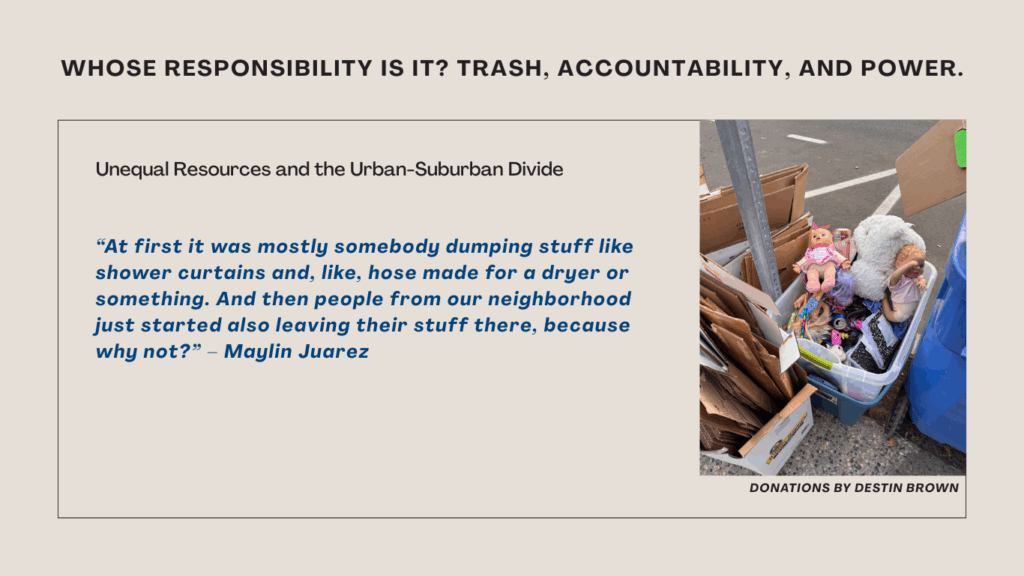
People from surrounding neighborhoods have also been known to dump trash on sidewalks in low-income communities to avoid paying fees at landfills, however, it then burdens local community members.
“At first it was mostly somebody dumping stuff like shower curtains and, like, hose made for a dryer or something. And then people from our neighborhood just started also leaving their stuff there, because why not?” – Maylinn Juarez
Another participant, Erica Crowley, provided an example in one of her PhotoVoice pictures along with her caption.
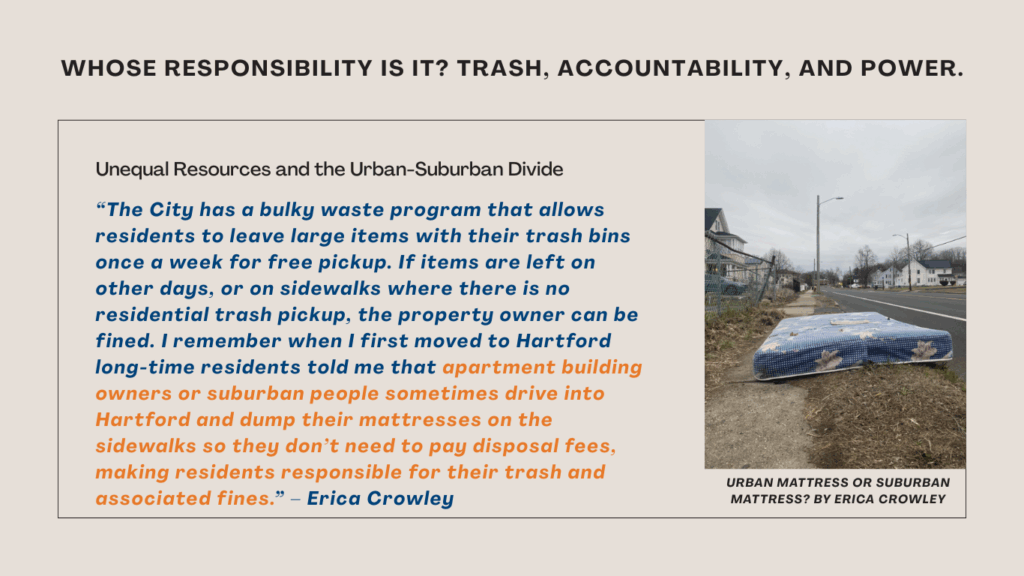
Participant JP Maylin provided an example in their PhotoVoice picture of a street in a low-income area full of overflowing trash, compared to the cleaner parts of Hartford: of a street in a low-income area full of overflowing trash, compared to the cleaner parts of Hartford:
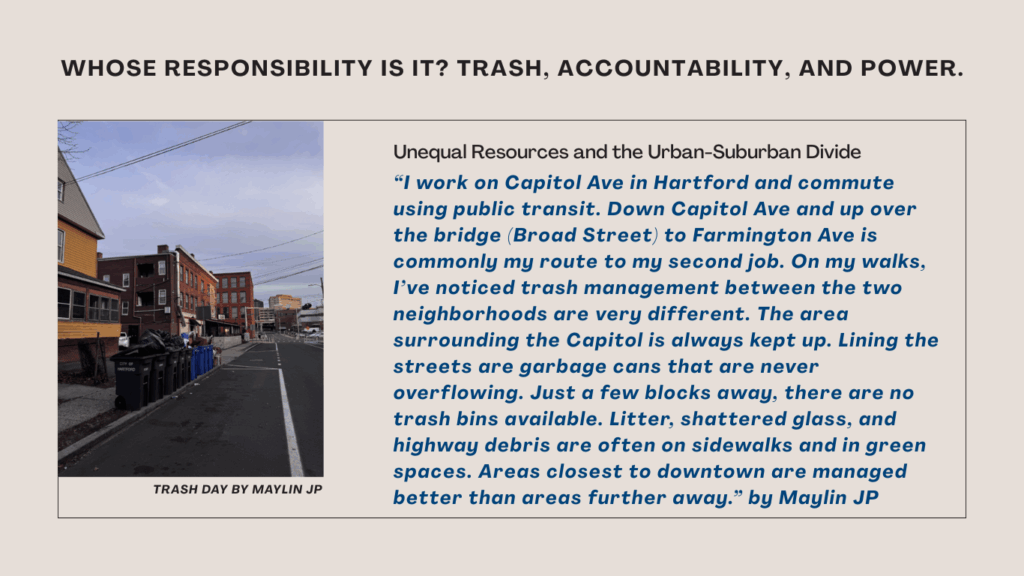
Imagining Solutions: What Can and Should Be Done?
Participants reflected on the emotional toll of living in Hartford neighborhoods overwhelmed by trash, sometimes placed there by residents of suburban towns. They expressed frustration from being blamed for waste management issues that are largely due to systemic failures from the city. Additionally, participants felt discouraged from participating in official meetings on waste management due to inaccessible language and a lack of real, visible outcomes, which reinforced their feelings of hopelessness and disempowerment.
While discussing remediation solutions was difficult due to a lack of information available, participants and Stowe facilitators encouraged one another to keep envisioning and sharing their dreams, knowing that collective hope can eventually lead to action. Some participants expressed hope for the future of the land that would give back to their communities, such as creating a public pool or recreation center. But, most of the conversation reflected on the institutional disillusionment they experienced founded in the continual lack of support they have endured.
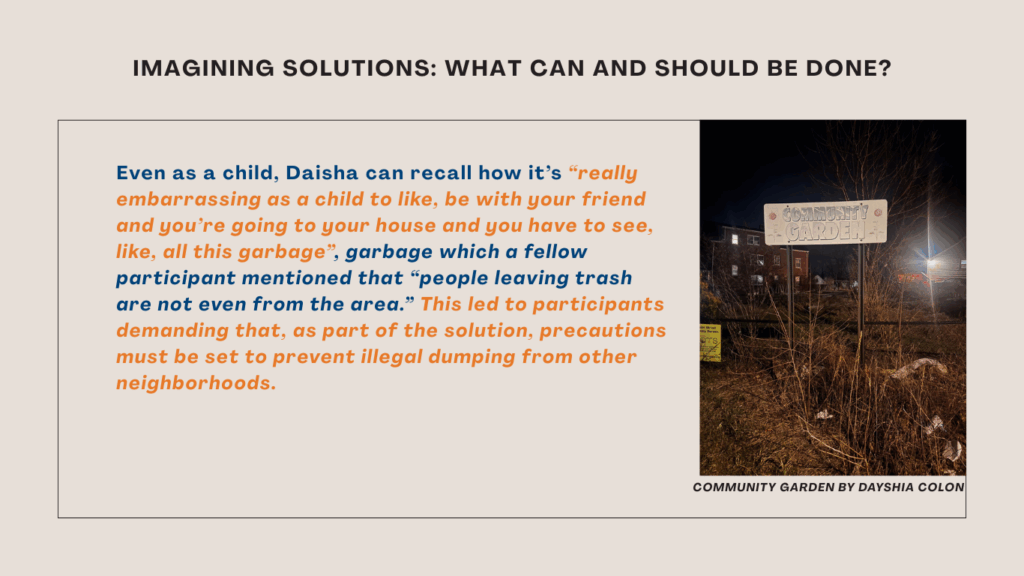
Even as a child, Dayshia can recall how it’s “really embarrassing as a child to like, be with your friend and you’re going to your house and you have to see, like, all this garbage”, garbage which a fellow participant mentioned that “people leaving trash are not even from the area.” This led to participants demanding that, as part of the solution, precautions must be set to prevent illegal dumping from other neighborhoods.
In fact, PhotoVoice participants felt that residents in the city of Hartford are the ones blamed for the waste management issues, despite this being a city issue. The combination of both realities lead to the formation of one potential solution involving the implementation of equitable waste management strategies. Since waste management isn’t prioritized, organization for community action can become increasingly difficult. Official meetings with city representatives on issues of waste management are not easily understandable to the average citizen, which limits community participation. As participant Maylinn described it:
“If I were to sit in like a session…like I wouldn’t understand like a single word of like what they’re talking about, like, because they’re going to be using all these big technical terms.” – Maylinn Juarez
This effectively limits local involvement, allowing the city to perpetuate inefficient waste management practices. Thus a second proposed solution involved the need for clear education and accessible language in waste management discussions. When asked about potential solutions to the trash mismanagement, one participant shared:
“Truthfully, I don’t care because when I have before, like, nothing happens, nothing ever happens. You know, nothing ever happens for the community. So it’s so hard to just, like, have an idea or suggestion because, like, literally nothing ever happens. So I am just like, I, I don’t care, you know. Like why am I going to put my energy into this to be disappointed again?” – Tatiana Hilario
Another consideration for how these issues may be mitigated extended to the development of programs to address long-term health consequences.
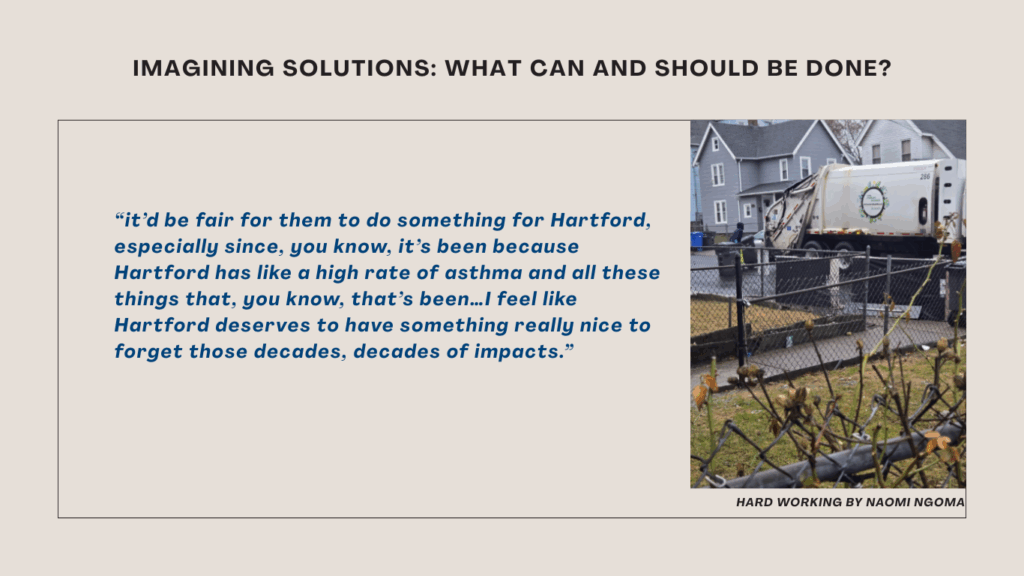
Although formulating concrete solutions for the years of negative effects or the land was difficult due to the lack of information available to participants, participants did not leave without forgetting their power as constituents, as people who are directly affected, and as individuals with voices.